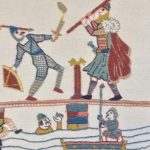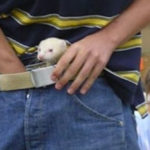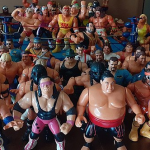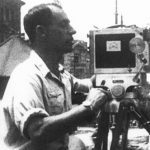 Mysteries
Mysteries  Mysteries
Mysteries  History
History 10 Surprising Stories About the Texas Rangers
 Humans
Humans 10 Philosophers Who Were Driven Mad by Their Own Theories
 Miscellaneous
Miscellaneous 10 Video-Game-Worthy Weapons and Armors from History
 Weird Stuff
Weird Stuff 10 Psychics Who Accurately Predicted Wartime Events
 The Arts
The Arts 10 Pieces of Art Inspired by a Broken Heart
 Health
Health 10 Science Fiction-Sounding New Medical Treatments
 History
History 10 Surprising Facts About the Father of Submarine Warfare
 Space
Space Ten Astonishing New Insights into Alien Worlds
 Weird Stuff
Weird Stuff 10 Bizarre Summer Solstice Rituals Still Practiced Today
 Mysteries
Mysteries Top 10 Haunting Facts About the Ghost Ship MV Alta
 History
History 10 Surprising Stories About the Texas Rangers
 Humans
Humans 10 Philosophers Who Were Driven Mad by Their Own Theories
Who's Behind Listverse?

Jamie Frater
Head Editor
Jamie founded Listverse due to an insatiable desire to share fascinating, obscure, and bizarre facts. He has been a guest speaker on numerous national radio and television stations and is a five time published author.
More About Us Miscellaneous
Miscellaneous 10 Video-Game-Worthy Weapons and Armors from History
 Weird Stuff
Weird Stuff 10 Psychics Who Accurately Predicted Wartime Events
 The Arts
The Arts 10 Pieces of Art Inspired by a Broken Heart
 Health
Health 10 Science Fiction-Sounding New Medical Treatments
 History
History 10 Surprising Facts About the Father of Submarine Warfare
 Space
Space Ten Astonishing New Insights into Alien Worlds
 Weird Stuff
Weird Stuff 10 Bizarre Summer Solstice Rituals Still Practiced Today
Ten Awful Genocides Often Forgotten by History
Genocide is one of the most horrific acts of violence that can be perpetrated. It involves the systematic destruction of a particular ethnic, racial, or religious group. Its awful intention is to wipe out that minority group entirely. The scale of human suffering that results from genocide is unimaginable. As students of history know, it typically involves mass killings, torture, and other forms of brutality.
Genocide is often fueled by deep-seated prejudices. Those choosing violence act on their intense desires to eliminate a particular unwanted group of people. It can be motivated by a desire for land, resources, or power. Or it can come from a desire to avenge real or perceived past wrongs. Regardless of the motivation, the consequences of genocide are devastating for survivors. It often leaves a lasting legacy of pain and trauma lasting for generations.
Take the Holocaust, for example. That genocide saw the systematic extermination of six million Jews by the Nazis during World War II. Of course, it is perhaps the most well-known example of genocide. Sadly, it is far from the only one. The Rwandan genocide of 1994 saw an estimated 800,000 Tutsis and moderate Hutus slaughtered. More recently, the ongoing genocide against the Rohingya people in Myanmar also shows the horror and devastation that genocide can bring.
The scars of these awful acts run deep for generations afterwards. But not all genocides are as well-known or studied as the Holocaust or the tragedy in Rwanda. In fact, some genocides have been mostly forgotten in the dustbin of history. In this list, you’ll learn about ten genocides they probably didn’t teach you in the history books.
Related: 10 Heartbreaking Facts About The Warsaw Ghetto
10 The Solomon Islands’ Tensions: Up To 1,000 Dead
The Tensions genocide was a dark period in the history of the Solomon Islands. It was marked by civil unrest, violence, and ethnic conflict. The conflict began in 1998 when militant groups from the populous Guadalcanal province started attacking migrants who had come over to work from nearby Malaita province. The Guadalcanal natives accused them of taking jobs and land after migrating. The violence soon escalated into a full-blown conflict that lasted for several years.
The clash resulted in the displacement of tens of thousands of people and the loss of hundreds of lives. Some accounts claim up to a thousand Malaitans were slaughtered. As many as 40,000 more braved the high seas on small boats to nearby Bougainville in Papua New Guinea. The conflict was eventually resolved with the intervention of the Regional Assistance Mission to the Solomon Islands (RAMSI) in 2003. But sadly, the scars of the genocide remain fresh to this day.
During the conflict, both sides committed numerous atrocities. Those awful acts included murder, rape, and torture. The militants from the Guadalcanal province were accused of targeting migrants from Malaita with homicidal rage. The Malaitan militants were accused of retaliating with violence and assaults of their own. The violence was fueled by underlying tensions between the two ethnic groups made worse by the Malaitans’ migration pattern.
The conflict had a profound impact on people throughout the Solomon Islands. For years after, many families were torn apart and entire communities destroyed. Sadly, even today, it may not be over. New attacks targeted at Chinese immigrants who own markets and stores in the nation’s capital of Honiara erupted in 2020 and 2021. While these problems have not risen to the level of The Tensions, observers are worried things could quickly get out of hand in the Pacific island nation.[1]
9 Herero and Nama Genocide: 80,000 Deaths
The Herero and Nama genocide was a tragic event that occurred in German South West Africa in 1904. The area, which is now known as Namibia, was home to the proud Herero and Nama peoples. Their genocide was a concerted effort by Germany to wipe them out and take their land. Initially, the conflict arose due to disputes over land and resources. The German settlers sought to expand their territory and control over the region. That desire put pressure on the Indigenous people.
The genocide began with the Battle of Waterberg. In it, the Herero people were vastly outnumbered and outgunned. This quickly led to a series of violent clashes. German forces used brutal tactics such as poisoning water sources. They even moved to herd Herero people into concentration camps. Many Herero people were worked to death in these camps. Others were subjected to medical experimentation and forced labor. The genocide resulted in the deaths of up to 80% of the Herero population. Today, historians estimate that number was as high as 80,000 people.
The aftermath of the genocide was equally devastating. After losing the battles, the Herero people also lost their land and traditional way of life. Germans continued to exert control over the region. In the years following the genocide, they even expanded their territory deeper into Namibia. The trauma and loss of the Herero people continued to be felt for generations. In fact, the genocide is still a contentious issue today.
The German government has recently acknowledged its role in the genocide. They have even begun the process of making amends, including offering a formal apology and funding development projects in Namibia. Even today, the 1904 Herero genocide serves as a stark reminder of the devastating impact of colonialism. Its modern update also exemplifies the ongoing struggle for justice and reconciliation in post-colonial societies.[2]
8 Kurdish Genocide: 185,000 Deaths
The Anfal campaign, also known as the Kurdish genocide, was a series of brutal attacks that took place in the Kurdistan region of Iraq from 1986 to 1989. The campaign was ordered by the Iraqi government led by Saddam Hussein. It was an attempt to suppress the Kurdish population’s autonomy movement.
The Anfal campaign began with a chemical weapons attack that killed hundreds of Kurds. That marked the first time a nation had used chemical weapons against its own population. Over the next several months, the Iraqi government continued perpetrating horrific acts of violence against the Kurdish people. They included bombings, executions, and mass killings.
The Anfal campaign resulted in the deaths of tens of thousands of Kurds—estimates ranging from 50,000 to as high as almost 185,000. Many Kurdish villages were destroyed, and their inhabitants were rounded up, detained, and executed without trial. The campaign was widely condemned by the international community over the years, with many countries imposing strict sanctions on Iraq.
The Anfal campaign is still considered one of the most brutal acts of violence against the Kurdish people. Even today, it has had a lasting impact on the Kurdish community. In the present, the Kurdish population continues to seek greater autonomy and recognition of their cultural identity. They also come together annually to remember the atrocities committed during Iraq’s Anfal atrocities.[3]
7 Mayan Genocide: 200,000 Deaths
Guatemala’s persecution of the Mayan people in the late 20th century is often referred to as the Mayan Genocide. The government’s campaign to eradicate the Maya was brutal and thorough. The army used a variety of tactics to destroy small, indigenous Mayan communities. The campaign was particularly intense during the 1980s.
In that decade, the government launched Operation Sophia. That was a secret plan to wipe out the entire Mayan population in the country. The plan involved killing 200,000 native people and displacing another 1.5 million more. Many of those displaced fled to Mexico. There, they lived perilous lives in refugee camps for years.
Guatemala’s violent tactics during the genocide were particularly heinous. Villages were destroyed, livestock was slaughtered, water supplies were poisoned, and sacred structures were desecrated. The Guatemalan military used rape, torture, and other forms of violence to terrorize the Mayans. Many people were forcibly kidnapped and disappeared—thousands of their bodies never recovered. The conflict only came to an end in 1996 after other nations intervened to sue for peace.
However, the effects of the genocide are still felt in Guatemala today—particularly among the surviving Mayan communities. Efforts to bring those responsible to justice have been slow too. There have been some recent developments in prosecuting those involved in the genocide, but Mayan activists want more movement toward justice.[4]
6 East Timor Genocide: 200,000 Deaths
East Timor is a small island country located in Southeast Asia. It was once a Portuguese colony—until Indonesia invaded in 1975. The Indonesian occupation lasted almost 25 years and was marked by widespread violence and genocide. In that time, it resulted in the deaths of up to 200,000 people. That was roughly one-quarter of East Timor’s entire population.
Indonesian forces used starvation as a weapon throughout the genocide. They even poisoned food and water with napalm and hazardous chemicals. Death squads executed thousands of people, often with savage cruelty. It was all an effort to sow terror and hopelessness among pro-independence supporters.
In 1999, after 78% of the population voted for independence, Indonesia withdrew from East Timor. The United Nations then quickly moved in to help rebuild the country. However, justice for the atrocities committed during the occupation has been slow to come. Indonesian generals have never been fully prosecuted for these crimes against humanity.
In the years since independence, armed groups have continued to cause violence. Some have destroyed villages. In total, they have murdered at least another 1,500 people. Despite the challenges faced by East Timor, the country has made progress in recent years. They even became a member of the UN in 2002. They also signed a treaty with Australia to resolve a maritime border dispute in 2018.
So while East Timor has faced immense challenges throughout its history, the country has progressed toward stability and independence. Still, the genocide they faced at the hands of Indonesia is one of the most vicious and long-lasting in recent history. That it is also one of the lesser-known genocides to take place—especially in the late 20th century—boggles the mind.[5]
5 Bangladesh Genocide: 3 Million Deaths
In 1971, Dhaka was the capital of East Pakistan. That province was ruled at the time by West Pakistan, which was all the way across the Indian subcontinent. The Bengali population in East Pakistan was a majority in the colony, and they resented the political and economic exploitation by their western counterparts. So they sought independence.
When West Pakistan ignored the election of Sheikh Mujibur Rahman—the leader of the separatist Awami League party—as East Pakistan’s prime minister, tensions bubbled up. Widespread military violence between Bengalis, Pakistanis, and Indians took place in East Pakistan from March to December 1971. During that time, the death toll registered at least 300,000 war deaths.
However, the full-scale genocide was yet to come. And its numbers only later came to light as world observers began to realize what happened to innocent civilians during the strife.
In late 1971, the American Consul General to Dhaka, Archer Blood, accused West Pakistan’s soldiers of “systematically eliminating” the Bengali independence movement. Blood claimed the West Pakistani troops were slaughtering Bengali patriots by the thousands. At the time, Blood’s claim was completely ignored by U.S. President Richard Nixon. That was because Nixon considered West Pakistan an important American ally in the Cold War.
But the atrocities were too massive to ignore. Mass rape was used to terrify and degrade Bengali women while men were slaughtered by the thousands. Years later, the true creation of a generation of “war babies” with West Pakistani blood came to light. Ultimately, more than 3 million Bengali people died in the year-long conflict.
The genocide finally ended on December 16, 1971, when Pakistan’s troops surrendered to invading Indian forces. The conflict had a profound impact on the Bengali population. The aftermath of the tragedy came to a high point, though: it gave them their own free nation—Bangladesh—and shaped the course of South Asian history for decades after.[6]
4 Greek Genocide: 1.5 Million Deaths
Many people know about the awful Armenian Genocide of the early 20th century. In that tragic instance, the rulers of the Ottoman Empire slaughtered more than 1 million Armenian people. Sadly, that wasn’t the only awful act perpetrated by the Ottomans. Greek communities in Thrace were also targeted in the 1910s. Their genocide saw the deaths of nearly 1.5 million Greeks.
Christians, like the Armenians, were the primary targets of the Ottoman Empire’s wrath. These people were subjected to unspeakable atrocities at the hands of Ottoman forces. They included rape, mass murder, death marches, deportations, and torture. The Ottoman Empire also kidnapped many Greeks and made them convert to Islam. Others were forced to labor in work camps as the Ottomans relentlessly destroyed Christian monuments and culture.
The horrors continued into the early 1920s without ceasing. Many Greek communities across the Ottoman Empire were affected. İzmit, situated roughly 60 miles (97 kilometers) from Istanbul, witnessed the murder of 12,000 people and the burning of around 30 Greek villages early in 1922. One particularly heinous act was the burning of Smyrna. It was a violent attack that concluded the Greco-Turkish war and resulted in the deaths of thousands, leaving the city in ruins.
The genocide ended with the Treaty of Lausanne. This document included a mandatory population exchange between Greece and Turkey. The treaty’s legacy is controversial, with some historians describing it as a pivotal precedent for forcibly relocating populations throughout the 20th century. Nevertheless, it finally ended the slaughter of the Greeks in what is now known as Turkey and ended the terrible genocide for good.[7]
3 Circassian Genocide: 1.5 Million Deaths
A respected British diplomat named Sir Francis Palgrave bore witness to the Circassian genocide in the early 19th century. He made a powerful observation about the tragedy that still haunts the world today. “Their only crime was not being Russian,” Palgrave later wrote of the Circassian people. Their genocide was the first of the 19th century. Carried out by Russian forces, it eliminated more than 90% of the Circassian people, sadly making it one of the most effective genocides in history.
The Circassians had inhabited the North Caucasus region in central Russia for thousands of years. But during the Russo-Circassian war, the Russian Empire sought to push their border south into the Caucasus mountains. Russia wanted greater access to the Black Sea, and they were willing to do whatever it had to do to get it. So, to achieve this goal, the empire’s forces used genocidal tactics against the Circassians. The Russians spoiled their food and destroyed their homes. They also carried out kidnappings, mass deportation, and summary executions.
In total, historians today believe that more than 1.5 million Circassian people were slaughtered by Russian forces as they swept south toward the Black Sea. Sadly, many people worldwide have never heard of this genocide or its after-effects. The Circassian diaspora can be found today across Turkey, Russia, and the wider world.
Descendants continue to remember what happened to their people. The “No Sochi” campaign opposed the 2014 Sochi Olympic Games since the Circassians are the indigenous people of the region where the games were held but were not part of the Olympics themselves. Of course, the Sochi Olympics were still carried out, so the protest movement didn’t succeed. But it brought light to one of the lesser-known genocides of all time.[8]
2 Cambodian Genocide: 2 Million Deaths
In the early 1970s, Cambodia was ravaged by civil war. The militant group Khmer Rouge made significant gains across the countryside as they planned to attack the capital city, Phnom Penh. Under the leadership of Pol Pot, the Khmer Rouge succeeded in their invasion in 1975. They declared that time “Year Zero,” marking the beginning of their radical communist agenda. The Khmer Rouge aimed to create an agrarian utopia by destroying all existing culture.
They wanted to force citizens into hard labor with minimal training—anyone who resisted or was suspected of doing so faced torture and death. Intellectuals were among the first to die. The mere possession of glasses was enough to qualify someone as one and mark them for execution. Over several years, the brutal regime’s stranglehold on Cambodia resulted in the death of as many as two million people. At the time, that total represented more than one-fifth of Cambodia’s population.
The Khmer Rouge’s reign of terror came to an end in 1979. That year, Vietnam invaded Cambodia with little resistance and took down the awful agenda. However, Pol Pot never faced justice for his crimes. He lived for another two decades and died in exile in 1998. The atrocities committed by the Khmer Rouge during their four-year rule still haunt Cambodia today. Survivors and their descendants continue to seek justice and healing.
Since the genocide, efforts have been made to preserve Cambodia’s cultural heritage. Many more Cambodians work to ensure that such horrors are never repeated. The legacy of the Khmer Rouge serves as a sobering reminder of the consequences of unchecked power and the importance of protecting human rights.[9]
1 Holodomor: 5 Million Deaths
Between 1932 and 1933, the Soviet Union carried out a brutal collectivization of agriculture in Ukraine. The Soviets imposed a communist farming policy which led to food confiscation and prohibited private property ownership. This move resulted in a catastrophic crop failure that caused a reduction in farm output. In turn, it disrupted supply chains in the region and led to dire food shortages. The man-made famine claimed the lives of approximately 3.9 million Ukrainians. An additional 1 million deaths occurred in other parts of the USSR.
Gareth Jones, a Welsh journalist, exposed the horrors of the famine to the world. He reported first-hand accounts of people who were living in utter desperation. They were forced to consume bark, grass, hay, and even each other’s flesh. Western journalists, including Pulitzer prize-winning writer Walter Duranty, were skeptical of famine reports. They chose to believe the Soviet-produced media that portrayed collectivization as a success. In fact, Duranty described famine reports themselves as “malicious propaganda” and dismissed Jones’s findings.
The Holodomor, as the famine was called, was denied not only by Stalin’s regime but also by many other Western journalists who were granted favors by the Soviets. Over time, though, the true extent of the forced famine would become known. Unfortunately, Gareth Jones paid the ultimate price for his courage years later. He was murdered during an assignment in Mongolia. Today, many believe the Soviets were responsible for his death.
The Holodomor remains a painful chapter in Ukrainian history. The impact of the event and its effect on generations of young people can still be felt to this day. The unnecessary famine was a tragedy that could have been avoided if not for the Soviet government’s brutal policies. Millions of lives could have been spared if not for such an evil oversight by that Russian-led realm.
Gareth Jones’s bravery in exposing the truth is a testament to the importance of free and independent journalism. Even after his death, Jones’s legacy serves as a reminder of the atrocities that can be committed when the truth is suppressed.[10]








